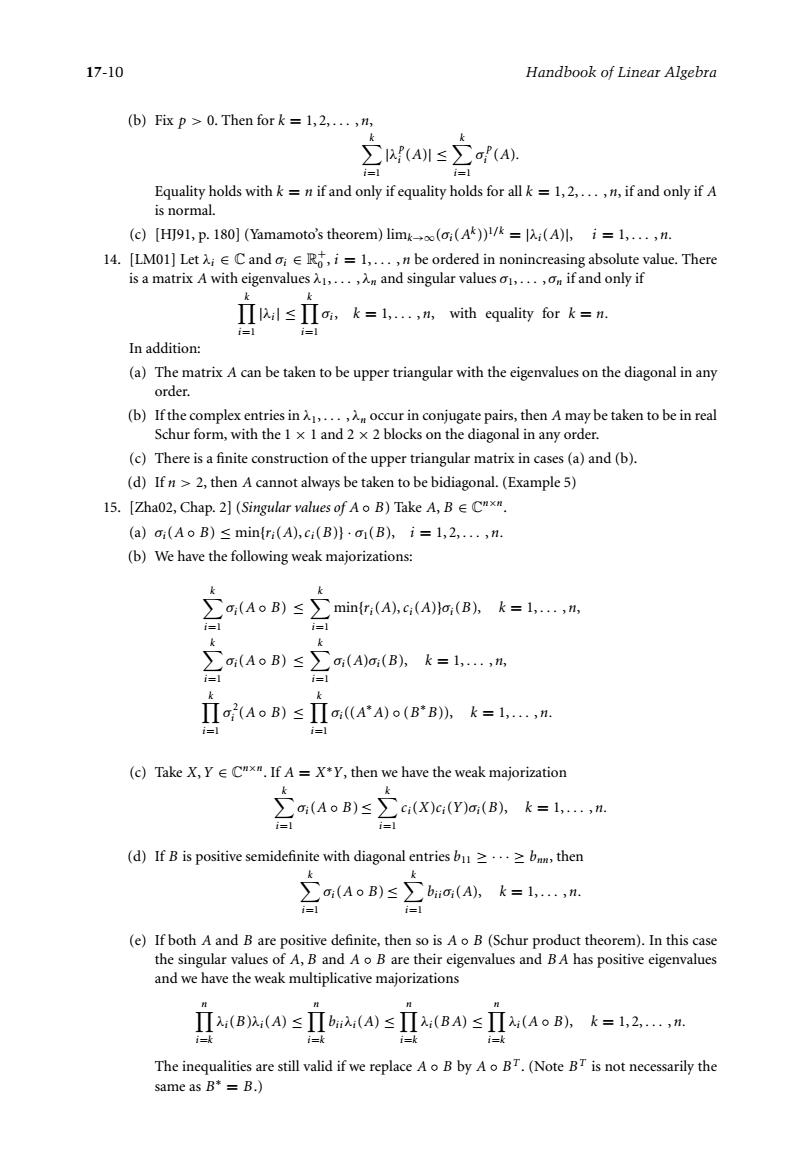正在加载图片...

17-10 Handbook of Linear Algebra (b)Fix p 0.Then fork=1,2....n ∑AAIs∑A. i Equality holds withk=n if and only if equality holds for all k=1,2.....n,if and only if A is normal. (c)[HJ91,p.180](Yamamoto's theorem)limg((A))=(A),i=1,...,n. 14.[LM01]LetCand,i=1,...,nbe ordered in nonincreasing absolute value.There is a matrix A with eigenvalues and singular values...if and only if Ⅱl≤Ⅱo,k=1,with cquality for=m In addition: (a)The matrix A can be taken to be upper triangular with the eigenvalues on the diagonal in any order. (b)Ifthe complex entries in ur in conjugate pairs,then A may be taken to be in real Schur form,with the 1x I and 2x 2 blocks on the diagonal in any order. (c)There is a finite construction of the upper triangular matrix in cases(a)and(b). (d)Ifn,then A cannot always be taken to be bidiagonal.(Example 5) 15.[Zha02,Chap.2](Singular values ofAo B)Take A,BCx". (a)o:(Ao B)s min(r:(A),ci(B)1-a1(B),i=1,2.....n. (b)We have the following weak majorizations: N Cmin(r (A),c(A)l;(B),=1.... ☐7Ao=a公o(g8以k=1 (c)Take X,YC"x".If A=XY,then we have the weak majorization (d)If B is positive semidefinite with diagonal entriesbbthen ∑(AoB)≤∑a(Ak=l i=l bositive definite then so is a o b (Schur product the If bothn an B ars their sigenvalues and the s eigenvalues and we have the weak multiplicative majorizations Π(B)(A)≤Ⅱ4(≤ΠA(BA≤Ⅱ(AoB.k=1,2, The inequalities are still valid if we replace Ao B by Ao BT.(Note BT is not necessarily the same as B*=B.)17-10 Handbook of Linear Algebra (b) Fix p > 0. Then for k = 1, 2, ... , n, k i=1 |λp i (A)| ≤ k i=1 σ p i (A). Equality holds with k = n if and only if equality holds for all k = 1, 2, ... , n, if and only if A is normal. (c) [HJ91, p. 180] (Yamamoto’s theorem) limk→∞(σi(Ak ))1/k = |λi(A)|, i = 1, ... , n. 14. [LM01] Let λi ∈ C and σi ∈ R+ 0 , i = 1, ... , n be ordered in nonincreasing absolute value. There is a matrix A with eigenvalues λ1, ... , λn and singular values σ1, ... , σn if and only if k i=1 |λi| ≤ k i=1 σi , k = 1, ... , n, with equality for k = n. In addition: (a) The matrix A can be taken to be upper triangular with the eigenvalues on the diagonal in any order. (b) If the complex entries in λ1, ... , λn occur in conjugate pairs, then A may be taken to be in real Schur form, with the 1 × 1 and 2 × 2 blocks on the diagonal in any order. (c) There is a finite construction of the upper triangular matrix in cases (a) and (b). (d) If n > 2, then A cannot always be taken to be bidiagonal. (Example 5) 15. [Zha02, Chap. 2] (Singular values of A ◦ B) Take A, B ∈ Cn×n. (a) σi(A ◦ B) ≤ min{ri(A),ci(B)} · σ1(B), i = 1, 2, ... , n. (b) We have the following weak majorizations: k i=1 σi(A ◦ B) ≤ k i=1 min{ri(A),ci(A)}σi(B), k = 1, ... , n, k i=1 σi(A ◦ B) ≤ k i=1 σi(A)σi(B), k = 1, ... , n, k i=1 σ2 i (A ◦ B) ≤ k i=1 σi((A∗A) ◦ (B∗B)), k = 1, ... , n. (c) Take X, Y ∈ Cn×n. If A = X∗Y, then we have the weak majorization k i=1 σi(A ◦ B) ≤ k i=1 ci(X)ci(Y)σi(B), k = 1, ... , n. (d) If B is positive semidefinite with diagonal entries b11 ≥···≥ bnn, then k i=1 σi(A ◦ B) ≤ k i=1 biiσi(A), k = 1, ... , n. (e) If both A and B are positive definite, then so is A ◦ B (Schur product theorem). In this case the singular values of A, B and A ◦ B are their eigenvalues and B A has positive eigenvalues and we have the weak multiplicative majorizations n i=k λi(B)λi(A) ≤ n i=k biiλi(A) ≤ n i=k λi(B A) ≤ n i=k λi(A ◦ B), k = 1, 2, ... , n. The inequalities are still valid if we replace A ◦ B by A ◦ B T . (Note B T is not necessarily the same as B∗ = B.)����������